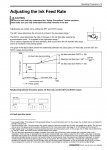D
Deleted member 16349
Guest
Hi All,
I need to talk with a control engineer or control technician who fully understands the speed control to the ink fountain roller on a Lithrone S40 press.
I have been told some things about this system that really seems strange but that can happen.
The person should understand the input reference signals to the drives. The discussions can be offline.
I will also try to find such a person by contacting Komori America directly.
Thanks
Erik
I need to talk with a control engineer or control technician who fully understands the speed control to the ink fountain roller on a Lithrone S40 press.
I have been told some things about this system that really seems strange but that can happen.
The person should understand the input reference signals to the drives. The discussions can be offline.
I will also try to find such a person by contacting Komori America directly.
Thanks
Erik














